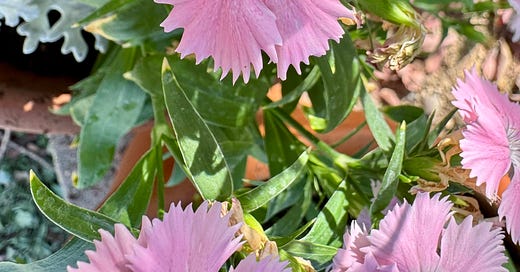Bedding Annuals Deserve a Place in the Wintery Desert Garden
Garden paths and things I’ve learned from walking down them
I have walked many garden paths. My favorite is hardly a path at all; rather, it is the sweeping curve of a grassy lawn that bordered a mixed perennial and annual planting at my grandma’s house just outside of Salt Lake City. It has so long occupied my memory as an image of what a flower garden should look like, that it has evolved into legend. More myth than memory. But there are some things I do remember, that perhaps really existed in that garden.
There was an old apricot tree in the middle of the lawn. The taste of apricots will always be the taste of those apricots: that strange sensation of dry and juicy, picked from the ground, warmed and rosy—a blushing, diminished peach.
In spring there were hundreds of tulips, some, along the drive, as dark as night. “They’re black tulips,” my grandma said. “But really they are just very, very purple.” That was my first introduction to color theory in the garden. And in the right light, perhaps as the apricot tree leafed out in spring, they were a purple so dark and unreflective of early spring light that to me they will always be black tulips, as rich and dark as the soil they grew from.
Her soil is also something I recall, the product of years of generous applications of well-composted rabbit manure. My grandpa cared for hundreds of rabbits: Angoras with their long, fussy hair. Opposite them, the small, petite Satins. The rabbits turned the hard, clay soil around their house into a macro and microbiome that would put the rain forest to shame.
This rich soil was mounded into beds. The beds were really enlarged foundation plantings that had slowly crept into the front yard, edging out grass bit by bit, as other, more interesting plants came to dominate the front garden. I remember so few of them, but bleeding hearts were there. I feel a stabbing ache just thinking of them, the delicate, arching fronds of the common and true variety: perfectly pink hearts cleaved by white daggers.
Bleeding hearts won’t grow here.
There was a small, backyard nursery in my grandma’s neighborhood that grew bedding plants. I went there once with her. Behind the house, in a clearing, there was a long hoop house.
Elm and box elder and maybe cottonwoods edged the clearing, but there was enough sun to grow petunias and marigolds and snapdragons for summer flowers. In the great Mojave desert these summer annuals do best in winter.
While my approach to gardening is mostly ecological, I will admit I am a gardener first. So I break a rule here or there to make magic of memories, turning them into scent, and color, and form. Summer bedding annuals, planted in the fall here, are among my favorite traditions.
It is about that time when a few winter annuals planted in pots now will be lush and floriferous come Thanksgiving. Scented stock and honeyed alyssum have become for me the smell of the holidays. I no longer imagine planting these old, dainty flowers and their faded pastels in the spring. Snapdragons, with their tall, playful flowers will go through three or four flowering cycles before it gets too hot. And nasturtium, if planted in a protected spot, will extend its vines all winter: little lily pads winding their way through the dry, winter air.
When my grandmother planted these then-summer annuals, she would dig a hole with her trowel and fill it with water, before plopping in the plant, usually a petunia, freshly sprung from a pony pack. This effort would go on throughout the bed, filling in all of the spaces not occupied by perennials. Her hands worked quickly and expertly, both gentle and firm in the way she pulled plants, teased apart their roots, and pressed them into their new homes.
In the Mojave desert, without a serious soil overhaul, these nostalgic annuals do much better in pots. This year, I’m growing snapdragons, alyssum, dianthus, vintage stock, and dusty miller. I’ve chosen all pink and white and silver, the color of a desert sunrise.
These grow well in winter light and rich, well-fertilized potting soil. The snapdragons will be cut back multiple times. I once timed it right for perfect Christmas blooms. Alyssum needs almost no attention. Dianthus and vintage stock benefit from deadheading.
There are many other annuals you could try. I look at geraniums with awe and horror and plant them anyway. They do well all winter, lasting until May, or until I get tired of watering them. They are quasi succulent and will take a bit of frost. In the morning, the leaves will be cold and frozen, but they thaw with hardly any harm. Not so for nasturtium. Frost of any kind will melt the leaves, but the vine will survive. Stock will bloom all winter. The same goes for calendula. All flowering slows down in the coldest, darkest time of year.
I do not know if the memory of my grandma’s garden resembles anything like the actual garden. It has become more myth than memory. But whatever the garden looked like, I’m glad it survives here and there in the just now more forgiving winter conditions of my Mojave garden.






